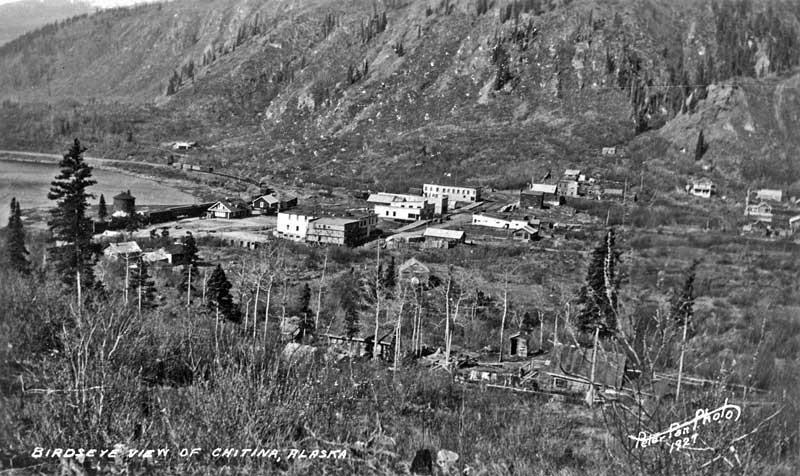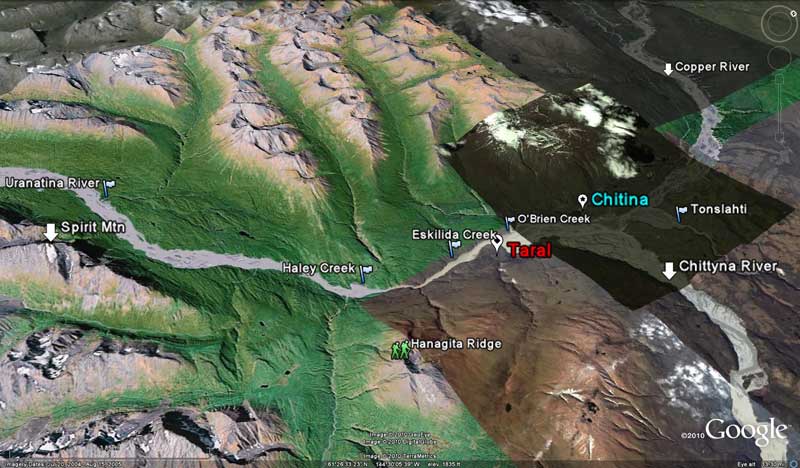
|
Kennecott
Special No. 74 announced its arrival into Chitina, CRNW mile
131, as all the CRNW trains did, with a series of whistle
blasts as it passed Eskilida Creek at mile 127. The sounds
reverberated all the way to the Copper River trestle
crossing--a mile beyond Chitina. The private train consisted
of the Kennecott and combine no. 52, but no caboose.
The engine heading this private consist was either #101 or
#102, an 80 ton mogul 2-6-0. These were the newest
engines the CRNW had in this year. The next year the first
of the 95-ton 70-series engines arrived. Nos. 70, 71 & 72
were built in 1915. Nos 73 & 74 were built in 1917. |
Lt. Mears'
private train at the Chitina depot, Sept,1914
--UAF, F.C. Mears, 84-75-408 |
one.”
The younger billiards player walked outside the no-name billiards hall
and faced the direction of the north-bound train. He caught the distant
sound of a second series of whistles from the large engine.
“They must have a new ket-chee-ten-eh . I’ve never heard that whistle
song before. Sounds like one of the new seventy-series, but its not any
of the four that I know. Must be another new one.”
The old man stepped outside onto the wooden boardwalk, still holding his
cue stick, but he could hear nothing.
“Tsuuye, you have good ears if you can tell the difference between the
whistles. I hear nothing at all. If they have another new
ket-chee-ten-eh, they must think they’re staying here. What’s that word,
Tsuuye? You’re the school boy.”
“Optimistic? How could they not be, Shee-ya? They’re running long ore
trains full of tsedi past Chittyna almost every day. The newspapers told
of the big Jumbo discovery last year, and this is supposed to be the
best year yet.”
“Don’t fall into the same snare in which the white man traps himself,
Tsuuye. One day the tsedi will be gone. They act like the tsedi will
always be here, but that’s foolishness. The tsedi will end, then they
will leave, and they will take their ket-chee-ten-eh thloo-da-kee with
them when they go.”
The teenager followed the older man back into the billiards hall.
Engine #74, one of the five 95-ton 2-8-2 series
engines used by the CRNW primarily for the ore trains, at Kennecott.
--AK Hst Soc Coll #84-48-27, UAF AK & Polar Regions Dept
“I sure hope they don’t,” he said under his breath. “I love those
ket-chee-ten-eh.”
Kennecott Special No. 74 announced its arrival into Chitina, CRNW mile
131, as all the CRNW trains did, with a series of whistle blasts as it
passed Eskilida Creek at mile 127. The sounds reverberated all the way
to the Copper River trestle crossing--a mile beyond Chitina. The private
train consisted of the Kennecott and combine no. 52, but no caboose. A
trailing car would have blocked the view from the observation deck. The
whistle blasted again as Engine No. 74 approached O’Brien Creek trestle,
which marked the southern approach into Chitina at mile 129.
It was a typical summer day for Chitina.
The temperatures by mid-afternoon had reached
the upper seventies. Only occasional breezes came from upriver and also
from the upper reaches of the Chugach Range. The town was built along
the northeast toe of the mountains which ran along the west bank of the
Copper River. With the late afternoon the shadows were just beginning to
overtake the small wilderness town within its rocky basin surroundings.
|

"Birds eye view of Chitina," 1927, showing the billiards hall--the long,
light-colored single-story structure on the right across Main Street from those
larger structures on the left. --Fred Machetanz collection, #73-75-86, UAF
AK & Polar Regions Dept.
|
|
The large, shiny, new Mikado engine screeched to a stop just
north of the Chitina terminal.
A small party of greeters in dress suitable for downtown Seattle stood
on the wide wooden platform in front of the depot waiting the arrival of
the Birch honeymoon party. When the train reached a full stop, the party
of four couples and two single men stepped off the rear of the train.
They paused to view the steep hills which tower around the town. Chitina
had only only two natural approaches One was the north-bound rail
approach, while the other was the north exit which was the Edgerton Road
to the Richardson Trail. The north railway exit was a tunnel driven
through the low-lying shale ridge above which sat over over a dozen
cabins known collectively as Chitina Heights. Beyond the tunnel the
railbed descended a hundred feet to meet the 900-foot Copper River
trestle one mile north of the depot.
F.A. Hansen's private railcar somewhere near
Chitina --W.A. RIchelsen files
The track south of Chitina approached the town just to the west of
Spirit Rock, the 600-foot tall hill which dominated the southern view of
Chitina, directly across Town Lake. The periphery of Town Lake became
the turn-around, making it possible by 1915 simultaneously run two
trains headed in different directions. The north-bound Mainline, also
known as the Cordova Local, ran the 131 miles from the Cordova wharf to
Chitina. The Chitina Local branch line was the mining branch extension
from CRNW mile 131 to Kennecott. Only with two trains on the line
concurrently was it possible to maintain daily service when the Jumbo
aerial tram opened in 1915, more than doubling the Kennecott mill
production.
While the foothills to the north blocked Chitina’s view of the
Wrangells, to the south, Spirit Mountain loomed above all else, jutting
ominously above Spirit Rock, presenting a magnificently wild and
primordial, if not spiritual appearance.

Spirit Rock, Town Lake, and part of
downtown Chitina during the 1920s and 30s. The Hotel Chitina is the large
building near the center. --Candy Waugaman Collection
|
After taking in the stunning scenery around Chitina, the group standing
on the wide platform began the brief walk to the first-class Hotel
Chitina. One man clearly stood out from the others. He was accompanied
by a much younger elegantly dressed woman, who appeared uncomfortably
out of place in the primitive, dusty northern frontier town. Only the
well-placed wooden walkways prevented the party from walking through
streets which had turned rough with mud puddles. F.A. Hansen, the CRNW
superintendent, along with his wife, had accompanied the arriving
guests.
The more prominent man walking beside Hansen had traveled through
Chitina once every year since the railroad established the town in 1910,
yet his face was familiar to only a select few.
The two Indians had stepped back outside to observe the unusual scene.
They stood alone in front of the billiards hall and card room silently
observing the entire procession. The younger and taller one was the
young half-breed . At only seventeen, he towered over all the other
Natives, having already grown to a full six-foot-one. He was of a
slender and wiry build. His long, straight, black hair was held in place
with a bandanna headband. Due to his mixed background, half Athabascan
and half Polish, Johnny was not only the tallest, but arguably one of
the more attractive Native males in the area. He had many female
followers, both Native and white. Sometimes with good looks and physical
prowess comes arrogance. Johnny was hardly immune from the weakness, but
certain members of his family, especially his mother Helen and his
sister Violet, were more than willing to step in on occasion to remind
Johnny that he was still just another mortal like the rest of them

Google-Earth view of the Chitina area, Uranatina to Kotsina (old
Tonshahti village).
|
No comments:
Post a Comment